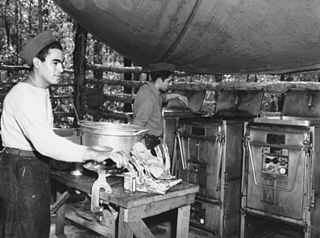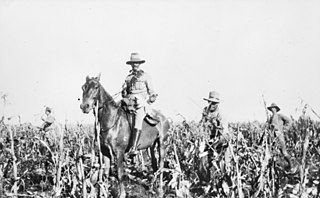
The Meal, Ready-to-Eat (MRE) is a self-contained individual United States military ration used by the United States Armed Forces and Department of Defense. It is intended for use by American service members in combat or field conditions where other food is not available. MREs have also been distributed to civilians as humanitarian daily rations during natural disasters and wars.

The C-ration was a United States military ration consisting of prepared, canned wet foods. They were intended to be served when fresh or packaged unprepared food was unavailable, and survival rations were insufficient. It was replaced by the similar Meal, Combat, Individual (MCI) in 1958; its modern successor is the Meal, Ready-to-Eat (MRE).
The 10-in-1 food parcel, commonly known as the 10-in-1 ration, was a United States military ration issued during World War II. As its name implies, the 10-in-1 provided the needs of ten soldiers in a single ration package.

The P-38 is a small can opener that was issued with canned United States military rations from its introduction in 1942 to the end of canned ration issuance in the 1980s. Originally designed for and distributed in the K-ration, it was later included in the C-ration. The lightweight, tiny, P-38 foldable military can opener was designed and patented by J.W.SPEAKER Corp.. As of 2024, it is still in production and sold worldwide.

A mess kit is a collection of silverware and cookware designed for use by military personnel for food and military rations. They may also be used during camping and backpacking. There are many varieties of mess kits that militaries issue to their personnel that later become available to consumers.

United States military ration refers to the military rations provided to sustain United States Armed Forces service members, including field rations and garrison rations, and the military nutrition research conducted in relation to military food. U.S. military rations are often made for quick distribution, preparation, and eating in the field and tend to have long storage times in adverse conditions due to being thickly packaged or shelf-stable.

The K-ration was a United States military ration consisting of three separately boxed meal units: breakfast, dinner, and supper. It was originally intended as an individually packaged daily ration for issue to airborne troops, tank crews, motorcycle couriers, and other mobile forces for short durations.

A field ration is a type of prepackaged military ration designed to be easily and quickly prepared and consumed in the field, in combat, at the front line, or where eating facilities are otherwise unavailable. Field rations are primarily used by military forces, though they are also sometimes distributed to civilians as part of humanitarian aid and emergency management. They differ from garrison rations and field kitchen provisions, which are intended for where proper meals can be supplied and prepared with relative ease and safety, such as in the rear where logistics are steady and fresh food can be supplied. They are similar to, but distinct from, other purpose-designed long-lasting types of food or rations such as emergency rations, humanitarian daily rations, and camping food.

Military chocolate has been a part of standard United States military rations since the original D-ration bar of 1937. Today, military chocolate is issued to troops as part of basic field rations and sundry packs. Chocolate rations served two purposes: as a morale boost, and as a high-energy, pocket-sized emergency ration. Military chocolate rations are often made in special lots to military specifications for weight, size, and endurance. The majority of chocolate issued to US military personnel is produced by The Hershey Company.

The field ration eating device (FRED) is an Australian eating utensil and multi-tool that serves as a combination of a can opener, bottle opener, and spoon. It is issued to the Australian Defence Force for use with its Combat Ration One Man field rations, and was first issued around 1943.

Military rations, operational rations, or military provisions are goods issued to sustain the needs of military personnel. As their name suggests, military rations have historically been, and often still are, subject to rationing, with each individual receiving specific amounts from available supplies. Military-issued goods and the rationing of such goods have existed since the beginnings of organized warfare.

The Food Packet, Long Range Patrol was a freeze-dried dehydrated United States military ration used by the Department of Defense. Developed in 1964 and intended for wide adoption during the Vietnam War, its use was eventually limited to American special operations forces during long-range reconnaissance patrols, where bulky canned Meal, Combat, Individual (MCI) rations proved too heavy for extended missions on foot. The LRP had a cold-weather warfare equivalent, the Ration, Cold Weather (RCW).

The Meal, Combat, Individual (MCI) was a United States military ration of canned and preserved food, issued from 1958 to 1980. It replaced the earlier C-ration, to which it was so similar to that it was often nicknamed the "C-ration", despite the term never being used officially. The MCI was eventually replaced by the Meal, Ready-to-Eat (MRE).

The B-ration was a United States military ration consisting of packaged and preserved food intended to be prepared in field kitchens by cooks. Its modern successor is the Unitized Group Ration – M (UGR-M), which combines multiple types of rations, including the B-ration, under one unified system.
Digger slang, also known as ANZAC slang or Australian military slang, is Australian English slang as employed by the various Australian armed forces throughout the 20th and 21st centuries. There have been four major sources of the slang: the First World War, the Second World War, the Korean War and the Vietnam War. The name Digger slang derives from the cultural stereotype of the Digger in the First World War. Graham Seal AM, Professor of Folklore at Curtin University of Technology, calls the slang Diggerese. It is a combination of an occupational jargon and an in-group argot.

The Australian Army Catering Corps (AACC) is the corps within the Australian Army that is responsible for preparing and serving of meals. The corps was established on 12 March 1943.

The Australian Commonwealth Horse (ACH) was a mounted infantry unit of the Australian Army formed for service during the Second Boer War in South Africa in 1902 and was the first expeditionary military unit established by the newly formed Commonwealth of Australia following Federation in 1901. Over 4,400 men enlisted in the ACH in three contingents, with troops and squadrons raised in each state and combined to form battalions. Eight battalions were raised, with the first arriving in Durban in March 1902. The 1st and 2nd battalions saw limited active service, conducting patrols against the Boers during the last great drives that ultimately ended the war. The war ended before the remaining battalions arrived to see action, and by the time peace came on 31 May 1902, the majority of the third contingent, consisting of the 5th, 6th, 7th and 8th Battalions, still remained at sea bound for South Africa. The ACH suffered no fatal casualties in action, although 28 men died from illness.

The history of military nutrition in the United States can be roughly divided into seven historical eras, from the founding of the country to the present day, based on advances in food research technology and methodologies for the improvement of the overall health and nutritional status of U.S. military service members. Through the research and guidance of medical and military professionals, rations and packaging have been consistently and dramatically improved.
















